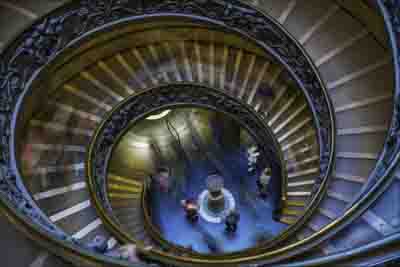Vatican Museums
| The School of Athens, painted by Raphael between 1509 and 1511, is a prominent fresco located in the Vatican's Apostolic Palace. Celebrated for its embodiment of Renaissance humanism, the artwork features an assembly of classical philosophers, including Plato and Aristotle, set in a grand architectural setting. This masterpiece reflects the blending of art, philosophy, and science, illustrating the intellectual spirit of the era and showcasing Raphael's mastery in composition and perspective. |
| Raphael's Parnassus is a fresco painted between 1510 and 1511 as part of the Stanza della Segnatura in the Vatican. It depicts the mythological Mount Parnassus, home to Apollo and the Muses, surrounded by famous poets like Homer, Dante, and Virgil. The fresco celebrates poetry, music, and the arts, symbolizing the harmony of divine inspiration and human creativity, aligning with the Renaissance ideals of intellectual achievement. At the center is Apollo, who is crowned with laurel and plays a lyre da braccio, the instrument considered to be a direct ancestor of the violin family of strings developed in the 2nd half of the 16th century. |
Melozzo da Forli, Angeli musicanti
| The Angeli musicanti ("Musician Angels") is a group of frescoes painted by Melozzo da Forli depicting angels playing music. Originally painted in the 15th century as part of a larger work, the frescoes were removed from their original location in the 18th century and are now housed in the Vatican Museums. These angels are often portrayed playing musical instruments, symbolizing the heavenly realm and the divine nature of music in worship. Instruments of that era appearing in this image (L-R): triangle, lute, lute, drum, rebec, vielle, tambourine, and lastly, lute. The frescoes reflect the integration of music into religious life and iconography. |
| This Spiral Staircase is a modern take on the famous Bramante Staircase within the Vatican Museums. Designed by architect Donato Bramante in the early 16th century, the original featured a gentle, spiraling ramp. In the 1930s, Giuseppe Momo reimagined the concept for increased visitor flow. His design replicates the double helix form but creates two separate, descending staircases – a visually stunning solution that efficiently guides visitors out of the museum right before the exit. This photo is a composite of 30 images, taken on a summer afternoon about 20 minutes before closing time, when many visitors were descending the staircase but mostly disappeared in the timelapse. |
| |




